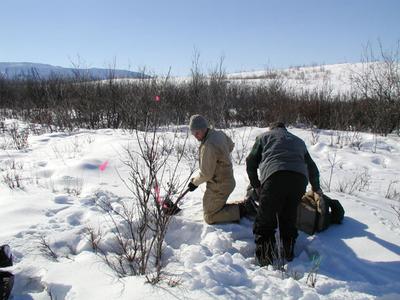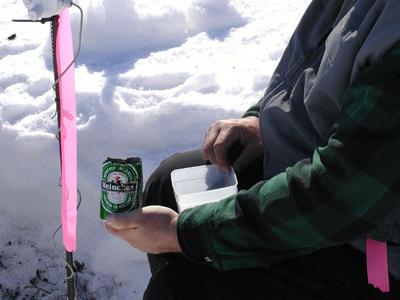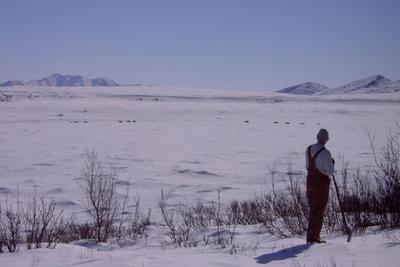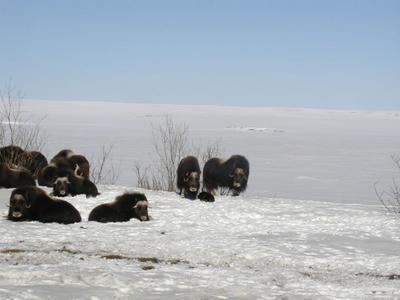5 May, 2002
Welcome to Toolik Lake
In the very first 24 hours, Toolik Lake has been both amazing and miserable.
We arrived to single digit temperatures and a very strong arctic wind. I
don't have a wind chill table handy but if we use the 40 F temperature from
lab trailer thermometer and figure an average wind speed of 30 miles per hour
with gusts to 45mph, maybe someone can tell me what the wind chill was last
night. Having been in the truck all day we were not dressed for these types
of severe conditions. The frigid wind seemed to just cut right through the
body. After checking in with the camp manager and meeting the small staff
here, we were given the grand tour of the Toolik camp. As it turns out we
arrived at Toolik at the very beginning of the season for the camp. This
means that many of the functions of the camp that we would have later in the
season currently are not available. The list of things we do not have seems
to be endless. The list includes things like no running water. Toolik Lake
itself is the source of the source of the water for the camp and the lake is
currently frozen over. To get fresh water, the camp staff drills a hole
through the three to four feet of ice of the every morning and fills several
barrels in the camp. The communications in the camp are no yet hooked up. A
new camp kitchen and dining hall is under construction so all meals are being
cooked and served There is currently a single phone line which is being
worked on and is only available between about 5:30pm and 7am. This last is
the greatest concern for me because I do not yet have a way to get my
journals out.
By the time our tour was over, I was very cold and very tired. I thought that
my sleeping bag in the dorm trailer would be a welcome respite, but the heat
failed in the dorm about midnight. Even though it was still bright out, it
was becoming even more frigid. By morning the temperature in my room was down
to about 350 F. I found myself being very grateful to the VECO Corporation
for providing me with a VERY warm sleeping bag. Needless to say, I had a very
hard time getting out of my sleeping bag and getting ready for the new day.
In addition to the discomfort of the cold, the wind blowing through the camp
made it sound as if the trailers would blow away at any minute. The good news
is that I was able to change rooms for this evening. I am in a trailer that
has been getting complaints of being too warm. After last night, I'm ready
for an oven of a room.
Once my room was changed, my misery was quelled somewhat by a really good
breakfast. Barbara, the head cook here has taken very good care of us so far.
One thing can be said for Toolik Lake is that there is plenty of food. After
breakfast we set out for our first collecting trip here on the North Slope.
Last September, the research team set out
a number of small habitats for arctic Click Beetles and temperature loggers
to record the conditions in the soil for the beetles (really, the habitat is
an aluminum can filled with soil and placed under a rock). Our job today is
to collect the beetles planted under the rocks and to download all of the
information from the data loggers. One interesting result of the days work
has been that we found that soil temperature rarely got much below freezing
and didn't go below - 10 F all winter. Once frozen, the soil temperature
remained fairly constant even when air temperatures fell as low as-40 F. This
means that while the beetles still must survive freezing conditions in the
winter, the beetles do not require adaptations to face the worst of arctic
winter conditions. It seems that the combination of the soil and the snow
pack provide a very nice insulation for the soil fauna.
One of the amazing events of the last 24 hours was the result of our
collecting and recovery trip this morning. The site where our beetles were
located is right on the edge of the Arctic National Wildlife Refuge (ANWR).
So today I got a first hand glimpse of the magnificent landscape of ANWR. To
make the trip even better, our drive took us right past one of ANWR's herds
of Musk Ox. We stopped to watch as the herd stripped the bark from a stand of
willow bushes. As we watched, we were able to see that the herd had increased
by the addition of three new calves in the last few days. Musk Ox were hunted
into extinction in Alaska and were reintroduced only about 50 years ago.
With my first day at Toolik Lake providing such overwhelming extremes, I
cannot begin to imagine what the rest of the week will be like.

We need to dig through snow, sometimes several feet deep to get to the beetle enclosures.

This is an example of the high tech materials we use for beetle enclosures.

While I was digging for beetles a herd of Caribou passed by on the plain below.

A herd of Musk Ox. You can see a calf in the middle of the frame. Its mother has the red ear tags.
Contact the TEA in the field at
.
If you cannot connect through your browser, copy the
TEA's e-mail address in the "To:" line of
your favorite e-mail package.
|
